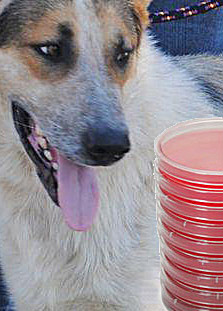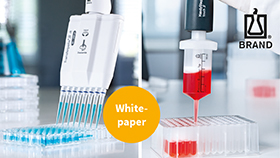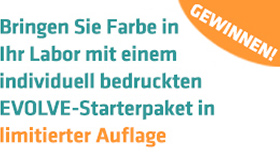 Haustiere gehören ja eigentlich nicht ins Labor. Aber den lieben Hund den ganzen Tag allein zu Hause lassen — das will man ja auch nicht. Also, Verbot hin oder her: Bello kommt mit!
Haustiere gehören ja eigentlich nicht ins Labor. Aber den lieben Hund den ganzen Tag allein zu Hause lassen — das will man ja auch nicht. Also, Verbot hin oder her: Bello kommt mit!
Ob der Hund der ehemaligen Münchnerin Birgit Puschner, jetzt an der University of California in Davis, nun „Bello“ hieß, ob es gar überhaupt ihr Hund war — das alles ist nicht gewiss. Sicher ist jedoch, dass da ein Hund in ihrem Labor war. Und der konnte offenbar den leckeren Düften nicht widerstehen, die seine feine Nase aus der Laborküche einfing. Er schlich also hinein und fraß kräftig Agar von den frisch gestapelten Platten. Dumm nur, dass einige davon giftiges Thallium-Acetat enthielten. Entsprechend groß war wohl die Aufregung, als man das Malheur mitsamt dem mittlerweile sicherlich schon leidenden Tier entdeckte.
Was aber machte Frau Puschner aus dem Zwischenfall? Ein Paper! „Thallium toxicosis in a dog consequent to ingestion of Mycoplasma agar plates“ ist dessen Titel und erschien schließlich im Journal of Veterinary Diagnostic Investigation, (vol. 24(1): 227-30). Eindrucksvoll schildert das Abstract, wie es dem armen Hund über die nächsten Monate erging:
A 1-year-old dog ingested a mixture of blood agar and Mycoplasma agar plates. The Mycoplasma agar plates contained thallium acetate, which resulted in an estimated minimum dose of 5 mg thallium acetate/kg bodyweight. Clinical signs over the course of 2–3 weeks included vomiting, diarrhea, weight loss, alopecia, dysphonia, ataxia, paresthesia, intension tremors, megaesophagus with subsequent aspiration pneumonia, and several seizure episodes. The dog was treated with intravenous fluids and placement of a gastric feeding tube. Thallium concentrations in hair were 8.2 µg/g in samples taken on day 19, 16.4 µg/g in samples taken 3 months after exposure, 13.4 µg/g in samples taken 5 months after exposure, and nondetectable in samples taken 7 months after exposure. The blood thallium concentration was 190 µg/l on day 19 and nondetectable 3 months after exposure. Megaesophagus and dysphonia continued for 10 months after exposure. This case of thallium poisoning following ingestion of mycoplasma agar plates demonstrates that unusual sources of thallium still exist and suggests that thallium toxicosis should be included in the list of differential diagnoses in dogs presented with megaesophagus, especially if alopecia and other unexplained peripheral neuropathies are present. Hair and blood samples are useful specimens to reach an accurate diagnosis even if taken several weeks post exposure. The postexposure blood and hair thallium concentrations reported in this case are useful data for diagnosticians investigating dogs with potential thallium poisoning.
Da hat Frau Puschner, ganz Wissenschaftlerin, aus der Not offenbar ganz schnell eine Tugend gemacht. Und auch wenn nicht wirklich verbürgt ist, dass sich die Geschichte hinter dem Paper ganz genauso abgespielt hat, drängt sie sich nach diesem Abstract eindeutig so auf. Was man bei Improbable Research übrigens genauso sieht.
Schlagworte: Agar, Haustier, Hund, Laborküche, Paper, Thallium, Toxikologie, Verbot, Vergiftung





